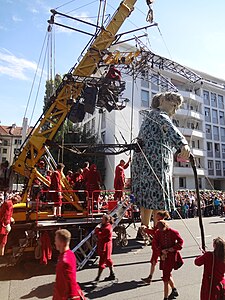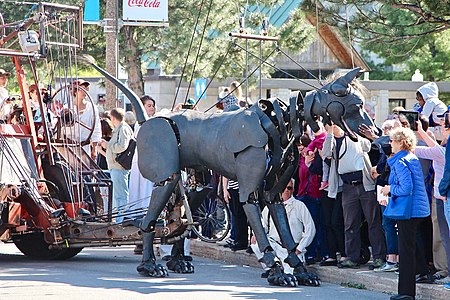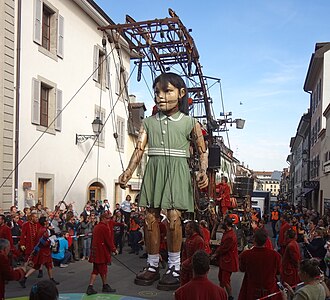
A puppeteer is a person who manipulates an inanimate object, called a puppet, to create the illusion that the puppet is alive. The puppet is often shaped like a human, animal, or legendary creature. The puppeteer may be visible to or hidden from the audience. A puppeteer can operate a puppet indirectly by the use of strings, rods, wires, electronics or directly by his or her own hands placed inside the puppet or holding it externally or any other part of the body- such as the legs. Some puppet styles require two or more puppeteers to work together to create a single puppet character.

Puppetry is a form of theatre or performance that involves the manipulation of puppets – inanimate objects, often resembling some type of human or animal figure, that are animated or manipulated by a human called a puppeteer. Such a performance is also known as a puppet production. The script for a puppet production is called a puppet play. Puppeteers use movements from hands and arms to control devices such as rods or strings to move the body, head, limbs, and in some cases the mouth and eyes of the puppet. The puppeteer sometimes speaks in the voice of the character of the puppet, while at other times they perform to a recorded soundtrack.

A marionette is a puppet controlled from above using wires or strings depending on regional variations. A marionette's puppeteer is called a marionettist. Marionettes are operated with the puppeteer hidden or revealed to an audience by using a vertical or horizontal control bar in different forms of theatres or entertainment venues. They have also been used in films and on television. The attachment of the strings varies according to its character or purpose.

Processional giants are costumed figures in European folklore, particularly present in Belgian, French, Portuguese and Spanish folkloric processions. The main feature of these figures is typically their papier maché head, whilst bodies are covered in clothing matching the costume's theme.
A hand puppet is a type of puppet that is controlled by the hand or hands that occupies the interior of the puppet. A glove puppet is a variation of hand puppets. Rod puppets require one of the puppeteer's hands inside the puppet glove holding a rod which controls the head, and the puppet's body then hangs over most or all of the forearm of the puppeteer, and possibly extends further. Other parts of the puppet may be controlled by different means, e.g., by rods operated by the puppeteer's free hand, or strings or levers pulled the head or body. A smaller variety, simple hand puppets often have no significant manipulable parts at all. Finger puppets are not hand puppets as they are used only on a finger.
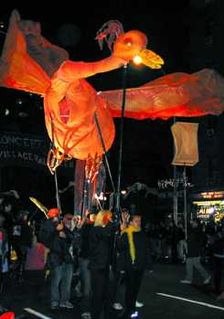
Sophia Michahelles is one of the two chief artists and puppeteers of Processional Arts Workshop, makers of pageant puppets and other processional art in upstate New York. She works closely with co-director Alex Kahn. The couple's work, under the informal moniker "Superior Concept Monsters" has been commissioned each year since 1998 to lead New York's Village Halloween Parade, the largest puppet parade and street-pageant of its kind in the United States, drawing two million spectators.
Digital puppetry is the manipulation and performance of digitally animated 2D or 3D figures and objects in a virtual environment that are rendered in real time by computers. It is most commonly used in filmmaking and television production, but has also been used in interactive theme park attractions and live theatre.
Tears of Joy Theatre was a puppet theatre company located in the Portland metropolitan area of Oregon. It was founded in 1971 by Janet and Reg Bradley. The company toured two shows a year to schools in Oregon, Washington, California, Idaho, Montana and Nevada. It toured libraries and puts on mainstage shows in the Portland Metro area yearly. It ended operations August 25, 2019.
Alex Kahn is an American visual/performance artist and co-founder of the arts ensemble Processional Arts Workshop. He is most widely known for his creation of the large-scale puppet performance works that lead New York's Village Halloween Parade each year.

A puppet is an object, often resembling a human, animal or mythical figure, that is animated or manipulated by a person called a puppeteer. The puppeteer uses movements of their hands, arms, or control devices such as rods or strings to move the body, head, limbs, and in some cases the mouth and eyes of the puppet. The puppeteer often speaks in the voice of the character of the puppet, and then synchronizes the movements of the puppet's mouth with this spoken part. The actions, gestures and spoken parts acted out by the puppeteer with the puppet are typically used in storytelling. Puppetry is a very ancient form of theatre which dates back to the 5th century BC in Ancient Greece. There are many different varieties of puppets, and they are made from a wide range of materials, depending on their form and intended use. They range from very simple in construction and operation to very complex.
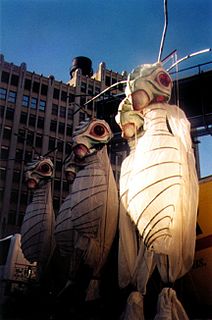
Processional Arts Workshop (PAW) is an ensemble of performing artists and theatrical technicians founded in 1998, devoted to pageant puppetry and processional art. They are also known by the name Superior Concept Monsters (SCM). They are best known for creating the large-scale puppet performances that lead New York's Village Halloween Parade.

The Puppeteers Cooperative is an association of puppeteers, musicians, dancers, and singers, working to form community bonds through the medium of puppets, parades, and pageants. It is an extremely loose affiliation - there is no membership as such, so that people are sometimes surprised to find themselves belonging to the group without having joined it.

World Puppetry Day is March 21. The idea came from the puppet theater artist Javad Zolfaghari from Iran. In 2000 at the XVIII Congress of the Union Internationale de la Marionnette, (UNIMA) in Magdeburg, he made the proposal for discussion. Two years later, at a meeting of the International Council of UNIMA in June 2002 in Atlanta, the date of the celebration was identified. The first celebration was in 2003.

Water puppetry is a tradition that dates back as far as the 11th century when it originated in the villages of the Red River Delta area of northern Vietnam. Today's Vietnamese water puppetry is a unique variation on the ancient Asian puppet tradition.
Anurupa Roy is a puppeteer, puppet designer and director of the puppet theater. Puppeteer Anurupa Roy's views puppetry as not "manipulating dolls with strings" but an amalgam of plastic and performing arts where sculptures, masks, figures, materials, found objects and narratives come together with music, movement, physicality and theater to create the theater where humans and puppets are co actors. She started at her group Katkatha in 1998 which was registered as the Katkatha Puppet Arts Trust 2006. She has directed over 15 shows for children and adults ranging from the Ramayana and Mahabharata to Shakespearean comedy to the Humayun-nama. The puppets used by the group range from 3 inches to forty feet. The shows have toured across Europe, Japan and South Asia. A major aspect of her work is using puppets for psycho social interventions in conflict areas like Kashmir, Sri Lanka and Manipur to Juvenile Remand homes. She has worked with youth and women across the country using puppets to raise awareness about HIV/AIDS and gender issues. She is a recipient of the Ustad Bismillah Khan Yuva Puraskar ine Puppetry(2006). She has been a visiting faculty at the University of California Los Angeles an Artists in Residence at Pro Helvetia Swiss Arts Council.

Frank Willard Ballard was an American puppeteer and educator. Serving as Professor of Dramatic Arts at the University of Connecticut from 1956 to 1989, Ballard developed internationally renowned programs for puppetry education. Opened in 1996 and moved to a prominent new location in downtown Storrs in 2014, the Ballard Institute and Museum of Puppetry was named in his honor.

Ferdinand Veike was an Estonian puppeteer actor.
Animal Cracker Conspiracy Puppet Company, or Animal Cracker Conspiracy (ACC), is a contemporary hybrid puppet company co-founded by Iain Gunn and Bridget Rountree that is invested in pushing the boundaries of kinetic performance, creating performances that "decenter expectations, open new avenues of thought, and invoke the uncanny." Their ongoing practice is based on a shared interest and exploration of where fine art, puppetry, performance art, circus, dance, film, and mixed media intersect. They perform nationally and internationally out of a multiplicity of venues such as La Jolla Playhouse in San Diego, California, where the company resides. ACC specializes in inclusive multimedia performances that encourage difficult discussions and foster community through local theater, street parades, and national tours.

Little Amal is a 3.5-metre (11 ft) partly-animatronic giant puppet which was used as the centrepiece of a performance art project called The Walk in 2021. The project was created by the British production companies The Walk Productions and Good Chance in collaboration with the South African Handspring Puppet Company. With the intention of celebrating human migration and cultural diversity, the puppet was carried during five months from the Syria-Turkey border via Europe to the United Kingdom, and walked and took part in locally arranged events in 65 towns and cities along the way. Little Amal was greeted at some venues by local dignitaries, such as Pope Francis, Vincent Nichols Archbishop of Westminster and Cllr Caroline Makinson, Mayor of Barnsley.

The Hatchling is a giant puppet dragon of kite construction; created for street theatre, performance art, procession and flight. It was designed and built by Trigger Productions Limited of Bristol, England, and premiered at a 2021 event in Plymouth, Devon, when the Hatchling processed through the streets, and was then flown as a kite over Plymouth Sound. The Hatchling also presented at The Queen's Platinum Jubilee Pageant, on 5 June 2022, leading a procession of 5,000 street performers along The Mall, London.








